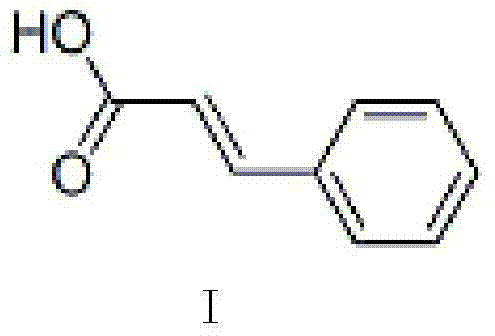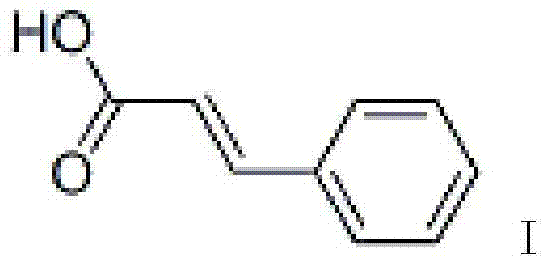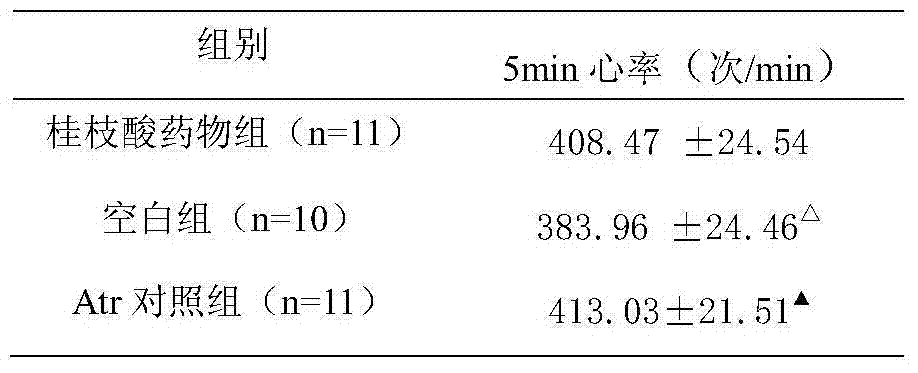Application of trans-cassia twig acid in preparing drug for resisting bradyarrhythmia
A technology of trans-cinnamonic acid and arrhythmia, which can be used in drug combinations, cardiovascular system diseases, etc., can solve the problems of patients with bradyarrhythmias that cannot be effectively treated due to financial or technical reasons, and achieve a wide coverage of the disease and a good industry. The effect of chemical prospect and low cost
- Summary
- Abstract
- Description
- Claims
- Application Information
AI Technical Summary
Problems solved by technology
Method used
Image
Examples
example 1
[0058] Example 1: Effect of trans-cinnamonic acid on the heart rate of normal rats
[0059] Take 30 healthy rats, half male and half female, weighing 220±30g, and randomly divide them into: ①Cinnamic acid drug group, ②Blank group, ③Positive control group, 10 rats in each group, half male and half male. After one week of adaptive feeding in the experimental environment, the rats were generally in good condition, and gavage was started.
[0060] In the cinnamonic acid group, 50-250 mg / kg of trans-cinnamic acid was dissolved in 1-2-propanediol to prepare a saturated solution, which was administered by gavage continuously for 7 days. The positive control group was intraperitoneally injected with atropine 0.15 mg / kg;
[0061] 2 hours after the last gavage, the rats were weighed, and rats were anesthetized by intraperitoneal injection of 3% pentobarbital sodium 50 mg / kg. The supine position was fixed, and the needle electrodes were connected subcutaneously to the limbs. The electro...
example 2
[0070] Example 2: Effect of trans-cinnamic acid on the heart rate of rats with acetylcholine-induced bradycardia
[0071] 30 healthy rats, half male and half female, weighing 220±30g, were randomly divided into: ① cinnamic acid group, ② acetylcholine model group, 10 rats in each group, half male and half male. After one week of adaptive feeding in the experimental environment, the rats were generally in good condition, and gavage was started.
[0072] In the cinnamonic acid group, 50-250 mg / kg of trans-cinnamic acid was dissolved in 1-2-propanediol to prepare a saturated solution, which was administered by gavage continuously for 7 days. The saline group was intragastrically administered for 7 days, and the positive control group was intraperitoneally injected with atropine 0.15 mg / kg;
[0073] 2 hours after the last gavage, the rats were weighed, and rats were anesthetized by intraperitoneal injection of 3% pentobarbital sodium 50 mg / kg. The supine position was fixed, and th...
example 3
[0081] Trans-cinnamic acid has the effect of resisting the bradyarrhythmia of the acetylcholine rat model, and can increase the heart rate of the rat model. Example 3: Effect of trans-cinnamic acid on the heart rate of rats with bradycardia induced by verapamil
[0082] Take 30 healthy rats, half male and half female, weighing 220±30g, and randomly divide them into: ① cinnamic acid group, ② verapamil model group, ③ positive control group, 10 rats in each group, half male and half male. After one week of adaptive feeding in the experimental environment, the rats were generally in good condition, and gavage was started.
[0083] In the cinnamonic acid group, 50-250 mg / kg of trans-cinnamic acid was dissolved in 1-2-propanediol to prepare a saturated solution, which was administered by gavage continuously for 7 days. The equal-volume normal saline group was given continuous intragastric administration for 7 days, and the positive control group was intraperitoneally injected with ...
PUM
 Login to View More
Login to View More Abstract
Description
Claims
Application Information
 Login to View More
Login to View More - R&D
- Intellectual Property
- Life Sciences
- Materials
- Tech Scout
- Unparalleled Data Quality
- Higher Quality Content
- 60% Fewer Hallucinations
Browse by: Latest US Patents, China's latest patents, Technical Efficacy Thesaurus, Application Domain, Technology Topic, Popular Technical Reports.
© 2025 PatSnap. All rights reserved.Legal|Privacy policy|Modern Slavery Act Transparency Statement|Sitemap|About US| Contact US: help@patsnap.com



